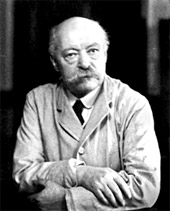Discovering that Intramuscular Injections Are Absorbed More Rapidly and Effectively than Subcutaneous Injections

Meltzer, Samuel
Courtesy of the Rockefeller Archive Center
The hormone adrenaline (epinephrine) was the first ever to be purified, isolated in 1901 by the industrial chemist Jokichi Takamine. Soon afterward, Rockefeller physiologist Samuel Meltzer (1851-1920) undertook a series of investigations into the effects of the "supra-renal extract," as it often was called. As he and his coworker John Auer (1875-1948) were studying the action of adrenaline on pupil dilation in rabbits they came up with some unpredicted results, which they speculated may have been due to their inadvertently delivering the adrenaline into the muscle rather than under the skin (subcutaneous) as intended. They carefully followed up on this chance event, and in 1905 they published the first experiments comparing the rates of absorption of substances injected subcutaneously and intramuscularly, concluding that "absorption from intramuscular tissue is incomparably faster than from subcutaneous tissue."
At the turn of the twentieth century, researchers and physicians generally assumed that intramuscular injections were absorbed into the blood at the same rate or more slowly than subcutaneous injections. In fact, the use of intramuscular injections seems hardly to have been considered. In studies of infectious disease, scientists typically injected infectious agents or antitoxins into the peritoneum of experimental mice. A few medications, including digitalis and camphor, were injected into muscle because subcutaneous administration was painful. But, as Meltzer observed, the "rate of absorption from muscles has never yet been a subject of scientific investigation."
In studies with rabbits, Meltzer and Auer systematically compared the two methods of administering adrenaline and its effect on blood pressure, dilation of the pupil, and prostration of the animals. In every instance, the same dose of adrenaline had a much larger effect when injected into muscle. Meltzer and Auer carried out parallel experiments with curare, morphine, and fluorescein, which yielded similar results—a dose of curare, for example, that had no effect when injected subcutaneously, paralyzed the animals within minutes when given intramuscularly. Based on this study, they suggested that intramuscular injection could offer a fast-acting way to deliver medications, in particular those that were effective in small doses.

The line on each figure represents variations of blood-pressure. The tracing were obtain from the carotid artery of rabbits after injections. From J Exp Med, 1905, 7: 59-78
Samuel Meltzer was born in Russia and trained in Germany, receiving the MD at the University of Berlin in 1882. He emigrated to the United States in 1883. He initially set up a private practice, and paid for the use of research facilities in William H. Welch's laboratory at Bellevue Hospital and Curtis and Prudden's laboratory at the College of Physicians and Surgeons at Columbia University. In 1903 Samuel Flexner invited Meltzer to join the Rockefeller Institute. Meltzer founded or cofounded a remarkable number of professional organizations, including the Harvey Society, the American Society for Clinical Investigation, the Federation of American Societies for Experimental Biology (FASEB), the Society for Experimental Biology and Medicine, and the American Association for Thoracic Surgery; he also served as president of each of these societies, as well as the American Gastroenterology Association, the American Physiological Society, and the Association of American Physicians.
John Auer received the BS from Michigan University (1898) and the MD from The Johns Hopkins University Medical School (1902). In 1903 he joined Samuel J. Meltzer's laboratory at the Rockefeller Institute. Auer was married to Meltzer's daughter Clara. He became professor of pharmacology at the St. Louis University School of Medicine in 1921. In addition to his work with Meltzer, Auer is remembered for his discovery of Auer bodies, the rod-shaped structures found in the cytoplasm of myoblasts in acute myelocytic leukemia.
Selected Publications
Meltzer SJ and Auer J. On the rate of absorption from intramuscular tissue. J Exp Med, 1905, 7: 59-78
http://jem.rupress.org/cgi/reprint/7/1/59
Meltzer SJ and Meltzer Auer C. Studies on the Paradoxical pupil dilatation caused by adrenalin, parts I-III. Am J Physiol, 1904, 11: 40-51
Further Reading
Meltzer A. Breath of Life: The Life and Works of Dr. Samuel James Meltzer. New York: Vantage, 1993
Samuel J. Meltzer (1851-1920): A Biographical Memoir. Washington, DC: National Academy of Sciences, 1921
Links
Meltzer A. Samuel James Meltzer, MD. March 22, 1851-November 7, 1920. Proc Soc Exp Biol Med, 2000, 223: 114-117
http://www.ebmonline.org/cgi/content/full/223/2/114
